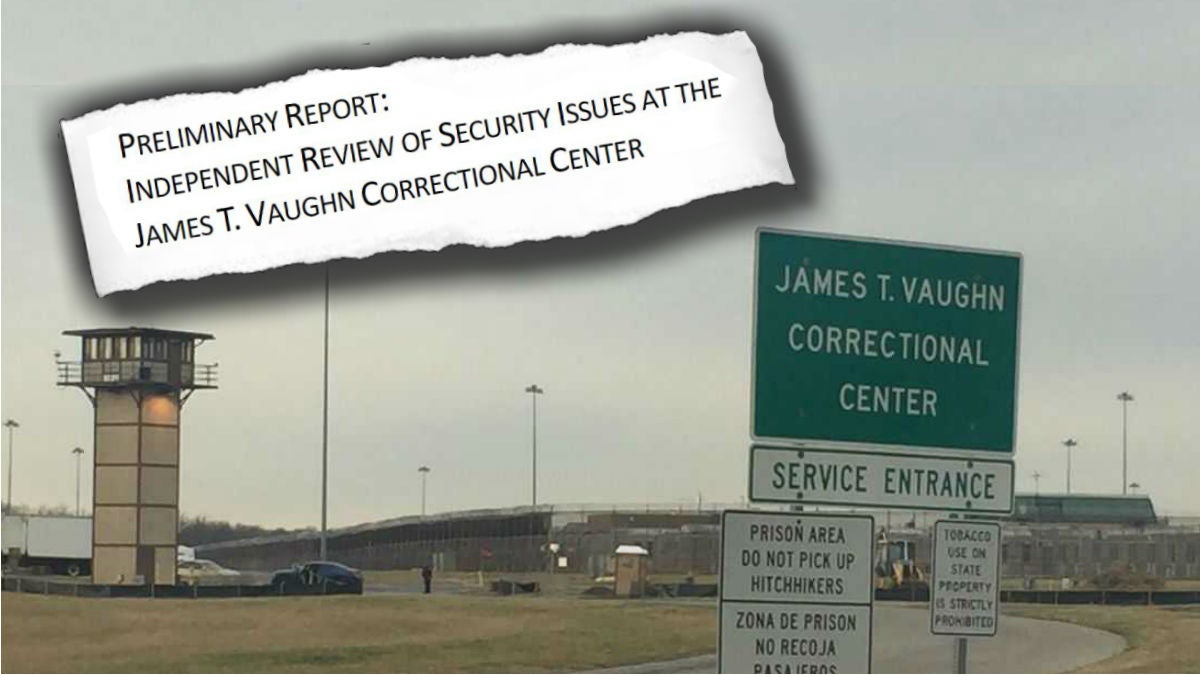‘Fertile ground for chaos and violence’ at Del. prison fueled deadly siege
Listen
Delaware is moving up to 330 inmates to Pennsylvania for up to two years to reduce mandatory overtime for officers and improve morale. (WHYY, file)
A preliminary review of the Delaware prison system concludes that a host of security and management problems led to February’s deadly prison riot at James T. Vaughn Correctional Center.
Poor training. Lack of communication. Inconsistent enforcement of prison rules. Gang members housed in the same cell.
The nearly 20-hour siege ended with the death of correctional officer Lt. Steven Floyd and injuries to several other officers
The systemic and operational dysfunction at the Department of Correction start at the top, with a lack of clear and consistent leadership, according to the review ordered by Gov. John Carney after the deadly siege on Feb. 1, just two weeks after he took office.
“There is no unifying sense of purpose or approach to the management of the JTVCC,” the report said.
The report also stressed that “existing security issues within the facility that may have served as precursors to the incident remain to be addressed.”
Communication during the hostage crisis was so poor, with three separate command posts in operation, that at one point the Vaughn warden threatened to shoot down a drone that Wilmington police had flown over the prison at the request of state police, the report said. The warden, who was later suspended and had since been reassigned, erroneously thought the drone was being operated by the news media.
The investigation, which is ongoing, is being led by Charles M. Oberly III, former U.S. attorney and attorney general for Delaware and retired Family Court Judge William L. Chapman Jr. Oberly replaced former Delaware Chief Justice Henry duPont Ridgely, who recused himself from the probe in April.
The daily focus of prison workers was just surviving, according to the report. “Line officers were most concerned with only trying to get through the day safely so that they could get home at the end of their shift.”
In large part because of that focus on personal safety, there was a lack of consistency in how employees did their jobs.
“Most everyone— administrators, supervisors, and line staff — end up ‘doing their own thing’ rather than following a clear and unified plan of strategy,” the report found.
The lack of consistency was also reported by inmates who talked to investigators.
“Inmates expressed frustration with shifting interpretations of rules and policies, as well as enforcement of those rules and policies by some staff,” the report said. “Some officers and supervisors have become complacent, others are unaware of what their job duties are, and others are very strict and operate their units in a very controlled manner, rarely deviating from the Delaware DOC policies and procedures.”
“They want consistency in the enforcement of the rules,” Oberly said. “They realize that some people are going to be strict, but just follow what your rules are so that we know day to day what we can do and what we can’t do.”
The report was supported by the Police Foundation, a group that has done similar work in other states including a review of the 2015 terrorist shooting in San Bernardino, Calif., and a review, currently underway, of the Pulse Nightclub attack in Orlando, Fla.
Investigators toured Vaughn, interviewed prison employees and inmates, and met with correction union leaders.
While the independent group praised the state and DOC for their cooperation during the investigation, investigators were limited because of the ongoing criminal investigation into the incident.
They could not access any police investigative reports or any DOC internal affairs reports, and they were working on a short deadline to issue the preliminary findings, the report said. “Can [the problems] be dealt with in a very short term basis? I don’t think so,” Oberly said. “You’re not going to change this thing next month.”
A more detailed final report will be issued in August, the report said.
“Horrible” training
Investigators heard repeated complaints about a lack of training for correction officers, and the poor quality of that training when it was done.
One correction officer told investigators that training at Vaughn is “horrible.” Leaders with the Correctional Officers Association of Delaware said “there have been no formal changes in DOC training since 1985,” according to the report.
That lack of good training “exposes the Delaware DOC to operational risks, safety and security issues, low morale and litigation,” the report found.
The report recommends that DOC make it a priority to be accredited by the American Correctional Association to improve standards and improve conditions for guards and inmates. It also recommends increasing training hours and updating training topics to meet national correctional standards.
“A clear sense of mission and vision, combined with a detailed plan for carrying out that mission, that includes roles for staff, conveys a sense of value and purpose for those involved and will provide the foundation upon which to move individual facilities and the department in a unified direction.”
“Ample evidence of burnout”
The investigation team also examined the long hours worked by correction officers at the prison. The report found workers are regularly kept at work even after the end of their shift, a practice that has become commonplace over the past six years. The report says Delaware is “overly relying on overtime” at Vaughn to compensate for high rates of turnover and high numbers of vacancy.
Low pay is a contributing factor to a high rate of turnover. DOC workers who start at a salary of about $32,000 can only expect their base pay to rise about $10,000 over the course of a 20-year employment at DOC.
Because of low pay and a lack of direction, the report says “the overall quality of the workforce has progressively declined at JTVCC.” The report goes on to say “complacency and acceptance of marginal performance has become the norm…There is ample evidence of burnout.”
The report lists four recommendations to address the staffing problems
Conduct a comprehensive staffing study to identify proper staffing levels at Vaughn.
Update and implement a practical fatigue/stress policy that accounts for work-life balance.
Create a promotional career ladder with competitive salaries, and merit-based recognition.
Provide Critical Incident Counseling and Training in Stress Management and Reduction, such as Mindfulness Training.
Riot response
During the riot, the report says there was a lack of communication among leadership.
There were three separate command posts established to respond to the incident which led to some confusion. The warden at Vaughn established a command post inside the prison, DOC leaders were set up at the nearby Delaware Emergency Management Agency bunker, and Delaware State Police and the FBI were set up outside of Vaughn. Those three command posts didn’t establish good communication with each other.
At one point, Delaware State Police asked Wilmington police to “to deploy a drone to fly over C-Building and monitor conditions live.” Warden David Pierce was unaware the drone “had been requested by the outside command post and at first threatened to shoot it down because he thought it was a news media drone,” the report said.
A lack of cameras inside the building where the incident happened also hindered the response. “While cameras may not have prevented the incident from occurring, they could have had a deterrent effect and could have provided additional information for post incident investigations had they been installed inside the housing unit,” the report said.
The way inmates were held in C-building also contributed to the violence.
Staffers told investigators “gang members were not only housed in the same cell, but also in adjacent cells and across the hall from each other — making communication and planning much easier. This situation was compounded by the fact that since October, all three tiers of C-Building were in the yard for recreation together.”
If not corrected, these issues will “continue provide fertile ground for chaos and violence in the facility,” the report said.
Another problem was a lack of activities for inmates. During inclement or cold weather, inmates were given their one hour of activity time in a common hallway, Oberly said. “You might have 40 inmates on a particular segment of C-building standing almost literally face to face with one table for an hour.”
Many workers told investigators they “had stopped trying because of fear, frustration, and/or exhaustion, and simply focus on making it through the day and going home.”
Thomas C. Crumplar, lead plaintiff’s attorney in a lawsuit against the state filed by Floyd and other injured guards, said the report “makes it clear the ‘crisis’ at Vaughn is so extreme that the staff can no longer effectively fulfill their mission and are reduced to simply trying to survive and make it home each day alive. I pray that a Delaware governor will finally take this crisis and fix our long broken DOC.”
WHYY is your source for fact-based, in-depth journalism and information. As a nonprofit organization, we rely on financial support from readers like you. Please give today.





